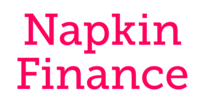Tuesday, May 10, 2016
How Napkin Finance Is Demystifying Personal Finance, One Napkin At A Time

For many people—particularly young people—the intricacies of personal finance and Wall Street can be very intimidating. How do you help young people figure out and understand finance, in a simple, easy to understand format? Los Angeles-based Napkin Finance (www.napkinfinance.com) has figured it out, with a series of very visual, highly engaging “napkins”, which explain, in a graphical way, many of the principles and basics of personal finance. The company has done so well, it recently connected with First Lady Michelle Obama to provide its “napkins” to students looking to go to college. We spoke with Tina Hay, founder and CEO of Napkin Finance, about the service and financial literacy.
What is Napkin Finance about?

Tina Hay: Napkin Finance is all about money and finance, in 30 seconds ore less. The idea is that we want to simplify complex topics, in a way that is fun, engaging, and entertaining. Learning about finance can be intimidating, and it's very rarely talked about in classrooms. We are taking the opportunity to build a relationship with Millennials and young students, at an early age, and help them navigate personal finance, and prepare for a lifetime of financial well being.
Where'd the idea for Napkin Finance come from?
Tina Hay: I come from a liberal arts background, but I went to business school. When I went to business school, I took a finance class with a bunch of bankers and consultants, and was almost failing out. The reason why, was I don't see things in numbers, I see things in a visual way, and in images. For me, it was easier to understand a topic when they are illustrated. For many people, that's the same way. Napkin Finance grew out of my own experience and challenges around the topic. That grew into these napkins, and into a platform, where we have the opportunity to teach individuals, including using videos, a glossary of finance terms, and other assets.
Why hadn't anyone done this before?
Tina Hay: It's very interesting, because visual thinking and mind mapping is a very old phenomenon. Even Einstein solved many of his problems visually, with images, as did Da Vinci, Sigmund Freud, and many others. Many complex issues have been solved with images, and then after that they put in the numbers into their explanations. It's a very old concept. It's just a matter of applying it to today's world of finance, because it just hasn't been available as it should be.
How do you go about creating those visuals?
Tina Hay: That's a great question. There is almost an art to making complex topics simple. We have worked with writers who have created content for Forbes and Bank of America, and it's not really about financial expertise. It's the ability to think in simple terms. We've been through literally hundreds of writers and experts to find people who can take complex topics, and make them simple. It's actually quite difficult to put these all on one napkin, and lots goes into the content and images, to do this the right way to put a complex topic in such a small space.
How did you end up working with the White House on providing content?
Tina Hay: It all started with a meeting at the White House, and it grew into creating a FAFSA napkin for the First Lady's office, which eventually became Michelle Obama's Napkin Finance course. The course initially helps teach students about paying for college, understanding loans, and how to complete their studies. The courses include napkins about paying for college, about student loans, saving for college, budgeting, and so on.
Are there other topics you will be covering or expanding into?
Tina Hay: The newest addition to our platform has been Napkinversity, which organizes courses around different topics, like Money 101, investing, or taxes. We also have a glossary of terms we call the WTF glossary, similar to the Urban Dictionary, but for financial terms. The next step is to help people with their finances, depending on their life stage. As a student, as someone going to college, someone getting married, we are figuring out what skills and resources they need access to, and are simplifying that and providing it to them through the platform.
These Naplins are all very educational and useful, but what's in it for you as a business?
Tina Hay: We have an actively engaged, user base that is interested in personal finance, and is interested in empowering themselves. That makes them a much better customer for banks or financial institutions. Not only do we engage with them on the topic, we connect with them with different milestones in their life, and also have a relationship which is much deeper than a bank or other financial partners might have. They have a much higher level of trust with us, because we're providing information, and resources, and services that are a best fit to them.
Thanks!